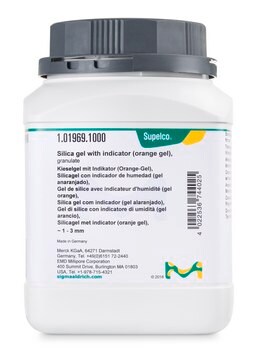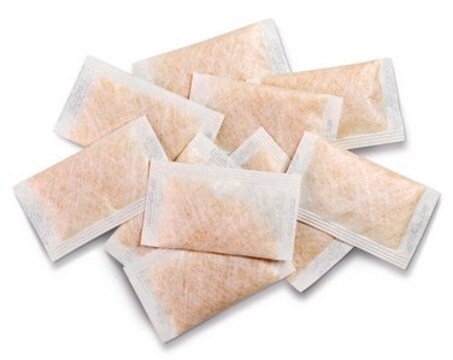94098
Drying pearls orange
Sinonimo/i:
Aluminum silicate, Silica gel orange
Autenticatiper visualizzare i prezzi riservati alla tua organizzazione & contrattuali
About This Item
Prodotti consigliati
Descrizione
heavy metal free
Livello qualitativo
Stato
beads
Capacità
>30 % absorption capacity (water)(at 80% rel. humidity, 25°C)
Descrizione generale
Drying pearls Orange (Silica gel orange), commonly used as a drying agent in laboratories, is suitable for drying all gases and solids. It is used in desiccators, drying towers, and absorption tubes. Silica gel orange provides longer storage conditions due to its large surface area which enables high absorption capacity. It also changes its color from orange to colorless after moisture absorption (approx. 6 wt% load).
Ricostituzione
regeneration by drying at 130 - 160 °C; do not heat above 160 °C
Codice della classe di stoccaggio
13 - Non Combustible Solids
Classe di pericolosità dell'acqua (WGK)
nwg
Punto d’infiammabilità (°F)
Not applicable
Punto d’infiammabilità (°C)
Not applicable
Dispositivi di protezione individuale
Eyeshields, Gloves, type N95 (US)
Scegli una delle versioni più recenti:
Possiedi già questo prodotto?
I documenti relativi ai prodotti acquistati recentemente sono disponibili nell’Archivio dei documenti.
I clienti hanno visto anche
Jamieson K Christie et al.
The journal of physical chemistry. B, 116(41), 12614-12620 (2012-09-18)
The low solubility (high durability) of yttrium aluminosilicate (YAS) glass is one of its most important properties for use in in situ radiotherapy. Simple parameters, such as silica or yttria content or network connectivity, are not sufficient to rationalize the
Mariaimmacolata Preianò et al.
Proteomics, 12(22), 3286-3294 (2012-09-22)
Herein we report the use of mesoporous aluminosilicate (MPAS) for the simultaneous extraction of peptides and lipids from complex body fluids such as human plasma and synovial fluid. We show that MPAS particles, given their mesostructural features with nanometric pore
Jin-Kyu Kang et al.
Environmental technology, 34(5-8), 703-710 (2013-07-11)
The aim of this study was to investigate the adhesion of bacteria (Escherichia coli) to pyrophyllite clay using batch and flow-through column experiments. Batch results demonstrated that pyrophyllite was effective in removing bacteria (94.5 +/- 2.0%) from aqueous solution (1
G Ipek Yucelen et al.
Nano letters, 12(2), 827-832 (2012-01-25)
We demonstrate new molecular-level concepts for constructing nanoscopic metal oxide objects. First, the diameters of metal oxide nanotubes are shaped with angstrom-level precision by controlling the shape of nanometer-scale precursors. Second, we measure (at the molecular level) the subtle relationships
Benjamin J Smith et al.
Proceedings of the National Academy of Sciences of the United States of America, 108(22), 8949-8954 (2011-05-13)
Sugar molecules adsorbed at hydrated inorganic oxide surfaces occur ubiquitously in nature and in technologically important materials and processes, including marine biomineralization, cement hydration, corrosion inhibition, bioadhesion, and bone resorption. Among these examples, surprisingly diverse hydration behaviors are observed for
Il team dei nostri ricercatori vanta grande esperienza in tutte le aree della ricerca quali Life Science, scienza dei materiali, sintesi chimica, cromatografia, discipline analitiche, ecc..
Contatta l'Assistenza Tecnica.



